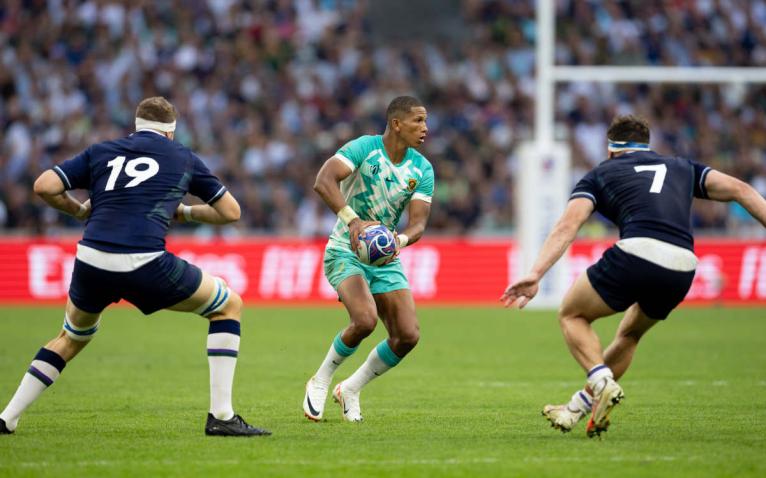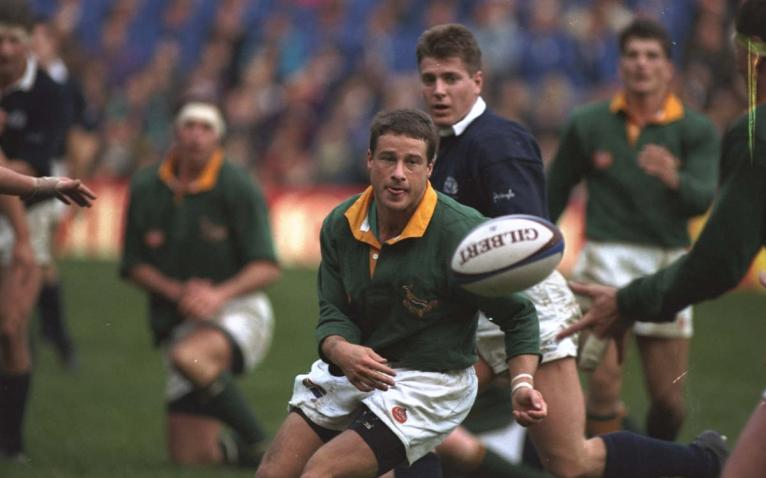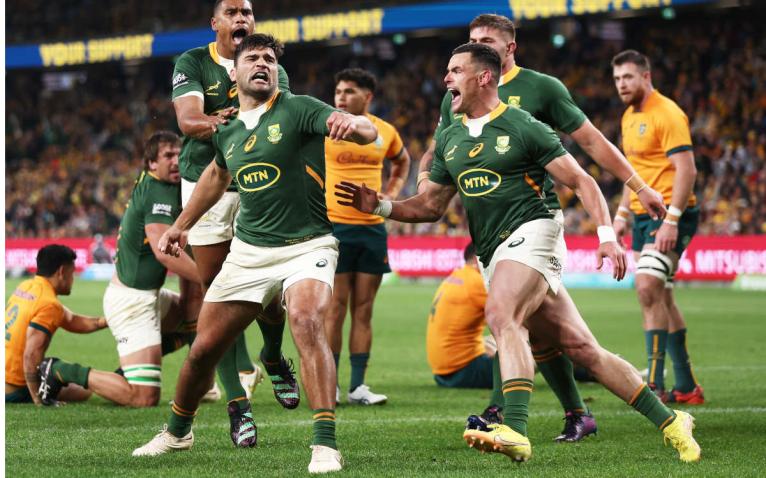One of rugby’s major draws can be found in the interconnectivity of the players on the pitch. Hulking tighthead props and chiselled wingers appear to be perched on different evolutionary branches, but their contributions from seemingly disparate universes directly impact one another.
A rugby team is more than the sum of its parts. Individual brilliance can, on occasion, illuminate a contest on its own, but more often than not it’s the cohesive machine that rumbles towards victory. This is why supremely talented players can find themselves on the bench or cut from the match-day 23 entirely. Square holes need square pegs after all.
“When we pick a team we don’t just always pick the best centre,” South Africa’s director of rugby, Rassie Erasmus, said this week “We pick the centre that compliments the guy with whom he plays. Is he a guy that is willing to go into a ruck and contest the ruck on the ground?”
That’s as good a place as any to pose a question ahead of the Springboks’ most important match for four years: Can Handre Pollard do a job at inside centre against France?
There are two reasons we’re even entertaining this. The first has to do with Manie Libbok’s right foot. Of all the goal-kickers at the World Cup who have taken aim at the poles at least eight times, Libbok has the second poorest success rate with 54.5%. Had Faf de Klerk not been asked to line-up two shots from his own half against Ireland, Libbok would be bottom of the pile.

The second reason we’re considering Pollard’s merits in the midfield is because of Libbok’s hands. No other South African fly-half in the professional era – and quite possibly no other South African fly-half ever – has been able to ignite a backline like Libbok.
He stands so close to the line that his scrum-half could almost hand him the ball. When Libbok decides to straighten and carry himself he breaks the defensive wall more often than any other 10 in the game. When he passes it on he finds runners at the apex of their charge. He is constantly putting team-mates into space and his cross-field kicking, which includes no-look diagonal dinks, are a potent weapon that keeps opposition fullbacks and wingers on high alert.
In short, one important component of Libbok’s game has been a disaster. The other has been a revelation. In knockout rugby, though, wild oscillations between the sublime and terrible can be costly. This is where Pollard, a safe pair of hands and a World Cup winning fly-half, comes in.
“The first thing is that a player has to be open to the switch,” explains Hennie le Roux, a fly-half by trade who shifted to inside centre around the time of the 1995 World Cup to accommodate the less flamboyant, but more reliable kicker, Joel Stransky.
There’s no doubt Pollard would be amenable to the change. But could he actually do a job there? South Africa’s attacking game has expanded over the last World Cup cycle but one thing has remained the same; that inside channel requires a hard-running battering ram
“I wasn’t so sure at first. But Kitch [Christie, South Africa’s coach] convinced me that it was the best thing for the team. Obviously I didn’t need to be told twice. I’d have done anything to help my country win a World Cup. And it worked out pretty well. To be fair to Joel, he had more refined kicking abilities. He proved himself to have done really well. I’ve got a lot of respect for what he did.”
There is no doubt that Pollard would be amenable to the change. But could he actually do a job there? South Africa’s attacking game has expanded over the last World Cup cycle but one thing has remained the same. That inside channel in midfield requires a hard-running battering ram who can punch holes in the line and provide go-forward ball. And in Damian de Allende and Andre Esterhuizen, the Boks have two formidable operators.

Since the start of 2022, both centres have achieved carry dominance 44% of the time and have comparable gainline success – Esterhuizen with 66%, de Allende with 63%. In that same period, Pollard’s numbers don’t stack up as he gets over the gainline from just 40% of his carries and has a modest 18% carry dominance.
Now it should be acknowledged that Pollard has spent much of the past two years injured, and his role at fly-half obviously dictates the sort of game he is asked to play. Even so, the gap between himself and the incumbents on these crucial metrics is stark.
“I’m not sure Handre can do that job that the Springboks need from their 12,” le Roux muses. “He’s a brilliant player, don’t get me wrong. He controls the tempo so well. I think he’s amazing.
“But is he going to knock guys over? Is he going to set a platform? Will he hammer guys in the tackle? I’m not so sure. That’s not really his game or his nature. The two proper centres are hard. They go looking for that contact. That’s what they’ve been doing their whole career. I think the Boks coaches would be creating a problem in an attempt to fix another.”
You can often get caught in two minds if you’re a natural 10. I know at times I wanted to get involved a bit more, and if you’re kicking off 10 you can start to feel like you’re not getting enough of the ball.
Hennie le Roux
This is a debate that has raged in English rugby for a generation. It’s why no England coach has figured out a perfect way to include George Ford and Owen Farrell in the same side. When they have played together in the past, it has forced a more physical threat out wide to 13, often resulting in Manu Tuilagi playing a cameo when he might otherwise have had a leading role.
“It’s freeing playing at 12, there’s less pressure to get it right all the time,” le Roux adds. “But you can often get caught in two minds if you’re a natural 10. I know at times I wanted to get involved a bit more, and if you’re kicking off 10 you can start to feel like you’re not getting enough of the ball.
“So you might go looking for work and that can create gaps in other places. That wasn’t so much of a problem when I was playing. Back then we played more on instinct and the teams you played against weren’t running the same sophisticated patterns the guys are running now.

“They’re all moving at such a high speed and they’re all such amazing athletes. I was a little guy. I’d probably struggle to play 12 in the modern day. Now there’s more of an emphasis on structure. If one thing falls away, everything else can follow.”
Unlike le Roux, Pollard is not a little guy. He’s 6ft 2in and weighs almost 16st. He is an enthusiastic sweeper in the rucks and is not a fly-half that needs to be hidden on defence. If he is selected at 12 he will meet every collision with more than just enthusiasm. He’ll hurl himself into the maw and continue to do so until he’s ordered off the pitch.
Pollard has a role to play in South Africa’s World Cup title defence. There’s no doubt about that. However, if Erasmus and Nienaber want to get the most out of him and the team, they might be inclined to leave him out and let others do what they do best.
But at what cost? To include an extra playmaker in the midfield? To take the pressure off Libbok’s goal-kicking? In the great balancing act that is team selections, busting through the guts and forcing France’s midfield to make tough tackles feels like a higher priority.
There is of course a third option. Pollard might get the nod to start at 10, consigning Libbok either to the bench or to the stands as a non-playing reserve. South Africa would gain a cool head, a more accurate goal-kicker and more heft at the inside channel, but they’d be losing something far more exciting and potent.
Pollard has a role to play in South Africa’s World Cup title defence. There’s no doubt about that. However, if Erasmus and Nienaber want to get the most out of him and the team, they might be inclined to leave him out and let others do what they do best.


Libbok libbok libbok attack attach attack. 5-2 split with Reinach and Pollard. Show me the Manie. However, Sous and PSDT can do 80 so can do 5-3 with confidence
I’d play Pollard first half and Libbok second half, that way you get the best of both players. Pollard comes in and sets up the team for success, settling their nerves so to speak - Libbok comes in and finishes the job, puts a dagger in the opposing defence and calls it a day. Put Grant Williams or Reinach on the bench to cover wing and scrum half. Willie to cover fullback. There’s your 5-3 split bench.